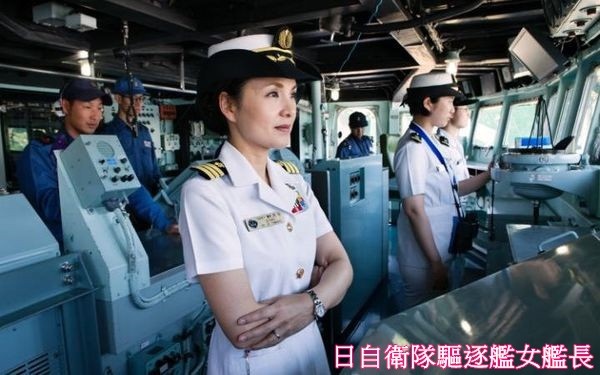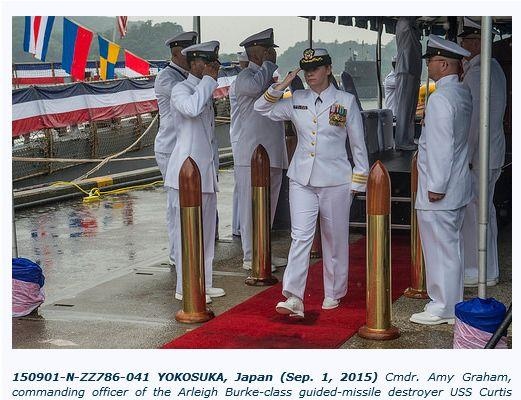

美驅逐艦駛入西沙 指揮官女艦長受矚目
2016/01/30 中央社即時新聞 CNA NEWS
五角大廈今天宣布,海軍一艘驅逐艦駛入中國大陸控制島嶼的南海敏感海域,這個海軍水面戰鬥單位的指揮官是一名女艦長,執行高度指標意義的南海巡弋任務,引起外界重視。
勃克級導向飛彈驅逐艦柯蒂斯魏柏號(USS CurtisWilbur,DDG-54)的指揮官(艦長)葛蘭姆(Amy Graham),於2015年9月於美軍在日本的橫須賀海軍基地升任指揮官職務,擔任巡弋西太平洋與南海地區的重大任務,在南海情勢升高之際,葛蘭姆指揮這艘火力強大的軍艦航經中方控制西沙海域,引起高度重視。
柯蒂斯魏柏號是美軍第7艦隊中第15驅逐艦中隊7艘勃克級驅逐艦中的1艘,於日本、關島與南海間的西太平洋海域巡防,曾多次參與美國與日韓間的演習。
美國海軍現役30多萬名官士兵中,有5萬多名女性,女性加入海軍沒有限制;國防部長卡特(Ashton Carter)2015年12月宣布,全面打破女性參與前線作戰軍種的限制,相較於其他軍種,女性在海軍的比例相當高。
女艦長趣聞:美巡洋艦女艦長粗暴飆船
2016-02-29 壹讀
在當今世界各國軍隊中,女性已成為重要力量,她們擔當指揮官、飛行員、水兵、特種兵等各種角色。而在海軍艦長的行列中也不乏女性的身影,並成為備受矚目的一個群體。
美國粗暴女艦長曾「飆船」
美國是當今世界上女兵最多的國家之一。目前,美軍中近90%的工作對女性開放。在美國海軍中,女性可以在戰鬥艦上服役,並已經出現了兩棲攻擊艦、飛彈巡洋艦等艦種的女艦長。
2010年美國媒體披露,美國海軍「考彭斯」號飛彈巡洋艦女艦長霍莉·格拉夫因濫用職權、粗暴對待下屬遭到解職。海軍督察長辦公室收到3起匿名投訴後,於2009年6月對格拉夫展開調查。這些投訴稱格拉夫粗暴對待下屬且以權謀私。海軍督察長辦公室厚達50頁的調查報告顯示,在接受問詢的36名「考彭斯」號船員中,有29人稱曾受到格拉夫言語侮辱。官兵們抱怨,格拉夫對他們惡語相加,甚至像對待小孩一樣命令官兵長時間罰站。曾飽受羞辱的軍官們在網上發起對格拉夫的「討伐」,他們給格拉夫起了個外號:「可怕的霍利」。調查還認定她讓部下幫她遛狗,並讓一名會彈鋼琴的下級軍官到她家為聖誕節派對助興。
官兵們還投訴,2009年2月格拉夫指揮「考彭斯」號在日本沖繩海域與一艘美國驅逐艦展開「飆船」,危及軍艦及艦上人員安全。按照英國《泰晤士報》的說法,格拉夫身為美國海軍飛彈巡洋艦首位女艦長,原本有望擢升為海軍少將,但個人言行不當導致其最終被解職。
英國打破女性海上禁地
任命女性艦長可謂是英國皇家海軍的一大創舉。2004年,32歲的夏洛特·阿特金森上尉被任命為「布雷肯」號掃雷艦艦長,成為英國皇家海軍首位女性軍艦指揮官。這一天距離英國皇家海軍宣布女軍官可與男軍官享受同樣待遇的決定,已經過去了整整14年。1990年之前,英國女性不能隨軍艦出航,更不用說擔任指揮官。
夏洛特·阿特金森出身軍人家庭,她的父親在英國皇家空軍服役。受家庭影響,夏洛特11歲時就立志加入英國皇家海軍。在英國海軍和紐西蘭海軍為期兩年的交流活動中,夏洛特被任命為「布雷肯」艦的指揮官。在「布雷肯」艦上,夏洛特·阿特金森是唯一的女性。
目前,英國海軍共有官兵41348人,其中女性占9%,女軍官占軍官總數的8%。2012年,韋斯特成為英國第一位戰鬥艦上的女艦長。她從軍以來擔任過4艘掃雷艦的艦長,目前的軍銜是少校,並即將晉升中校,4月接任巡防艦「波特蘭」號艦長。當上艦長以後,韋斯特擁有專屬的勤務兵和官艙。不過,依照英軍傳統,除非她獲邀跟其他軍官一起用晚餐,否則艦長都是自己吃晚飯。
此外,英國皇家海軍還委任43歲的穆爾指揮「第一巡邏艇中隊」,她成為首位指揮小型軍方船隊的女性指揮官。
日本女性首任護衛艦艦長
2013年3月,日本防衛大學畢業的兩名女性自衛官首次被任命為海上自衛隊護衛艦訓練艦艦長,這在日本歷史上尚屬首次。這兩名女性自衛官分別是41歲的大谷三穗和39歲的東良子,都是日本防衛大學的第一期女學生,她們被任命為廣島縣基地兩艘護衛艦訓練艦的最高長官。兩名女艦長經驗豐富,其中一名還擔任過現役護衛艦的副艦長。據悉,女艦長已經在日本的海洋觀測艦、訓練支援艦等艦種上出現過,但作為護衛艦艦長尚屬首次。
韓國首位女海警出任艦長
1月25日,韓國海警出現成立60年來的首位女艦長,掌管東海海警1513艦。這位34歲的女艦長高有美出生釜山,自小嚮往海上生活,從韓國海洋大學畢業後,於2002年成為海警。2003年成為第一位登艦執勤的女海警。報導稱,韓國社會普遍仍存在某種程度的男尊女卑概念,在航海方面表現尤甚,警備艦向來是「女性止步」。高有美加入海警之前也曾遭人質疑,如今則要指揮一艘1500噸級的警備艦,艦上還為她打造了一間備有化妝室和淋浴間的特別寢室。她2008年就曾擔任過釜山海警1503艦的副艦長,發揮出女性的細心特質,將艦上勤務打理得可圈可點。
全球華人首位女艦長 打報告轉任軍訓教官
2012年11月24日 ETtoday政治新聞
面對國軍即將轉型募兵制,今年國軍募兵結果卻是男兵招募不足、女兵爆滿破表的陽衰陰盛現象。雖然出現女性從軍熱潮是好事,但民進黨立委薛凌24日指出,婚姻跟家庭仍是影響優秀女性軍官升遷發展的重要因素,就她所知,「全球華人第一位女艦長」謝艾潔,已打報告轉任軍訓教官,理由是「個人生涯規劃」。
薛凌表示,海軍軍官謝艾潔在2007年底風光接任錦江艦長後,曾在出海執勤前,因孩子生病無法親自照顧而含淚出勤務,在歷任一年半艦長職務後,即因「家庭因素」自行提出中斷「指揮職艦資」申請,也就是提出申請,往後不要再派任她從事海上「指揮職」勤務職務。
服務於海軍教準部的謝艾潔,在今年元旦晉升中校後,已打報告轉任軍訓教官職場發展,並且在11月17、18日考完轉任考試,預計12月中旬放榜,明年1月6日受訓、2月16日派往軍訓單位報到。
薛凌分析,目前國軍女性官士兵人數目前已超過1萬5千人,占全軍志願役人員達百分之11點59,其中女性軍、士官更已超過3500人。儘管女性在軍中發展受到妥善照顧,但因為受到華人傳統文化觀念的約制,女性官兵常得在家庭與仕途發展選邊站。謝艾潔身為人妻、人母與媳婦卻無法兼顧家庭與軍事勤務,讓這位當年被視為全球華人第一位女艦長的風雲人物,因家庭與職業兩難抉擇而選擇淡出。
而繼謝艾潔之後的國軍第二位女艦長海軍鄱江軍艦艦長林美菁少校目前未婚,目前在作戰部隊職務最高的女性軍官,陸軍第58砲指部政戰主任辜麗都上校也未婚,儘管幾位國軍女將官都能兼顧家庭及軍旅生涯,但包括柴惠珍、潘愛珠、池玉蘭非作戰部隊出身,若依正常「經管」,女性官兵要在軍中發展,作戰部隊的歷練不能少,而已婚女性如果派駐作戰部隊任職,婚姻與家庭多少會影響升遷。
薛凌強調,一位海軍指揮職的艦長養成不易,甚至比訓練一位飛官還需要更大的投資,但正當謝艾潔已晉升中校,可以往「二級艦艦長指揮職」歷練的資歷後,她卻因為「家庭因素」或「個人生涯規劃」選擇離開,這是非常可惜的,軍方在擴大招收女兵的同時,應正視女性官兵處於婚姻、家庭與軍旅生涯的問題。(2012年11月24日 ETtoday政治新聞)
海軍一三一艦隊鄱江軍艦艦長李曉馨少校,是中華民國海軍第三位女性艦長,畢業於海軍官校正期九十年班,曾任電戰官、資管官、作戰長、艦務官、副艦長等艦艇資歷,去年七月派任鄱江軍艦接下艦長一職,對李曉馨個人而言,「艦長」是一項具有高度挑戰性的職務,除了是對她學識、專業能力的肯定外,更是一種榮耀。(資料來源 : 軍聞社 2013/02/08)
資料來源 : 軍聞社 2013/02/08
皇家海軍首位穆斯林女艦長
日自衛隊首現驅逐艦女艦長
2016年02月29日 中時電子報
據中新網引述日本媒體報導,日本海上自衛隊二等海佐(相當於海軍中校)大谷三穗首開先例,2月29日在橫須賀基地就任「山霧」號護衛艦艦長,成為日本首位女性現役護衛艦艦長,她將率領約220名隊員。
據日本海自橫須賀地方總監部介紹,44歲的大谷出生於大阪府吹田市,為防衛大學首期女性學員,於1996年畢業。2013年時,她成為負責訓練初級幹部的練習艦首位女艦長。 
在4.2萬名日本海上自衛隊員中,約有2400名女隊員。而「山霧」號上配有女性居住區及廁所,約有10名女隊員。
觀察者網軍事觀察員表示,「山霧」號護衛艦其實是驅逐艦,而「護衛艦」是日本自衛隊對軍艦的統稱。
「山霧」號是「朝霧」級驅逐艦二號艦,1989年服役。自村雨級等新型驅逐艦服役後,於2004年降編轉為訓練艦。2011年,「山霧」號重新複役,編入護衛艦隊直轄第11護衛隊,駐留在橫須賀。(中時電子報)
軍艦行進曲 日本女艦長指揮出港
發佈日期:2015年7月5日
https://youtu.be/_-uEfXl2NbY
若網頁無法觀看,則請點選YouTube連結網址,前往YouTube觀看。
Commander Miho Ootani on the bridge of the Yamagiri Credit: Androniki Christodoulou
5 June 2016 • 2:57pm
It is no easy task being captain of a Japanese warship.
There are China’s rising maritime ambitions, North Korea’s sanction-flouting missile antics and the shifting parameters of a pacifist constitution to deal with.
And for Commander Miho Otani, there is one more challenge to add to the list: the responsibility that goes hand in hand with being the nation’s first female captain of a Japanese destroyer.
Commander Otani, 45, made Japanese maritime history earlier this year when she was promoted to the senior-ranking position of captain of the Yamagiri destroyer, overseeing a crew of 220, only ten of whom are women.
The Yamagiri, a destroyer, moored at Yokosuka army base near Tokyo Credit: Androniki Christodoulou
The Maritime Self-Defence Force (MSDF) appointment marked a major step forward for Japanese women in the armed forces, long renowned as a male dominated world mirroring the nation’s sharp gender imbalance across the professional spectrum.
Today, there are 2,530 female MSDF personnel out of 41,774, with defence officials having set the fairly modest goal of raising the percentage of women service members from 6 per cent to 10 per cent within 15 years.
Commander Otani, however, has long been blazing a trail for women within the MSDF, with a growing list of “firsts” under her belt: she was one of the first female graduates at the National Defence Academy and more recently, she become the first female skipper of a training destroyer in 2013.
Her latest promotion carries even greater significance, with Commander Otani, who is also a married mother, facing a myriad of sensitive geo-political challenges, ranging from increasingly heated territorial tensions to tempering the rising maritime power of China.
It’s also a timely appointment for the prime minister Shinzo Abe, neatly complementing his policies of womenomics which aim to help revitalise the world’s third largest economy by supporting more women in the workplace.
However, speaking to the Telegraph on board the destroyer Yamagiri, docked in a picturesque green bay at the Funakoshi base in Yokosuka, 28 miles south of Tokyo, Commander Otani conceded her path had not always been smooth sailing.
After marrying at the age of 29, she was immediately asked by a male colleague when she was going to leave her job – a common assumption still facing many working Japanese women today.

Miho Ootani takes the captain's chair Credit: Androniki Christodoulou
She also admitted that male attitudes still needed to change today, in order to make policies supporting working women effective, while admitting her own personal “dilemma” of attempting to balance her career with being the mother of a now 12-year-old daughter.
Poised, polite and cautiously friendly, Commander Otani, dressed in immaculate top-to-toe whites with a neat black bow tying back her hair, talked from the head of a table in a meeting room with military-style clocks, photographs of Japan’s most senior politicians (all men) and reproduction Impressionist paintings on the walls.
Describing the inspiration behind the start of her maritime career more than 20 yeas ago, she said: “I was living life as a regular university student and I saw the Gulf War on the news.
“I was shocked to see what was going on in the world and how different it was from my life in Japan. I felt a sort of patriotism when I saw the news. That’s when I saw a newspaper ad for the National Defence Academy (NAD) recruiting female officers and I decided to join.”
She smiles recalling how she first encountered opposition e not from her male classmates, but closer to home: “My family was opposed to the idea. My father felt that the NDA was not a place for a woman to study, it was more a man’s thing.”
This, however, failed to curtail her ambitions in carving a new path for female officers: “I wasn’t really thinking in terms of going up the ranks. I felt more compelled to fulfill my duties as one of the first female students of the NDA and to pave the way for future female students who would follow in my footsteps and open doors for them. I feel responsible as a female to open up doors for other female officers.”
During the interview, Commander Otani was cautious in providing specific examples of the gender discrimination that she and her female colleagues might have experienced in the MSDF.
However, after describing the moment as a junior lieutenant officer when she was asked when she was quitting her job after marrying, she said: “Back then, people were just not used to working with women so they did not know how females would work. So I felt responsible as a female officer to show everyone - with my own work ethics and attitude – that I could do the same jobs that my male colleagues could do too.”
As the mother of a daughter, plus having been married twice (her current husband is a fellow destroyer captain), Commander Otani is acutely aware of the modern day struggles facing working women trying to balance family with careers.
“My work is on a ship, so I have to be away from my family for many months at a time,” she said. “So I might have to ask my parents to help take care of my children. I feel the dilemma of not being there to raise my child.”
Among the biggest challenges facing women in the armed forces was not the task of creating gender-balanced policies – but the challenges of implementing them in a famously hard working culture, according to Commander Otani.
“Women can actually take three years leave after a child is born,” she said. “That’s longer than in the US. But the problem is that the policies are there, but no one is able to actually take advantage of them. It’s really about the mentality of people – especially male officers – together they have to come up with ideas to change this, so they can actually utilise these policies.”
The pursuit of a new generation of young recruits has prompted the MSDF to position itself increasingly as a modern and attractive work prospect – as reflected in initiatives such as so-called Sailor Idol, a nationwide contest to find the most popular male and female sailors.
The ten female crew members who work on board the Yamagiri most likely count themselves as particularly lucky to be working for the nation’s first female captain – with Commander Otani even hosting regular “joshikai” (female gatherings).
Among them was Mayu Kanzaki, 28, Japan’s first female gunnery officer, who spoke with warm appreciation of her captain: “She is very friendly and very fair. She takes care of the officers and their families. She thinks it’s important for us to have a private life and feels responsible for everyone on board.”
And the main topic of conversation during her “joshikai”? “Gossiping,” said Officer Kanzaki with a laugh.
Commander Otani’s appointment was “highly significant”, marking new levels of support for female officers in the MSDF, according to Garren Mulloy, a British associate professor at the faculty of International Relations at Daito Bunka University in Saitama prefecture.
“The Japan Self-Defence Forces have generally been considered to be far behind the UK, US, Denmark, Australia and other armed forces in their consideration of women,” said Professor Mulloy. “This is not just a clear statement that there has been a sea change in policies and attitudes, but that the Japanese have caught up very rapidly and successfully.”
He added: “The socialisation factors within Japanese society make for a very much male dominated culture, and women who can learn to navigate and manage that environment will do well, but that will probably be a minority of women,” he said.
“The biggest challenge is possibly too much attention on her gender and not enough on her capabilities as a naval commander. Also as the trail blazer, any issue, error, or fault could be highlighted and used as an example of how 'women react', but this is what every officer in every force in the world has faced.”
Perhaps unsurprisingly, however, Commander Otani insisted that she ultimately felt unhindered by her gender:“I feel that male and females are very much equal in terms of careers. I get the same salary. […]There are some duties I can’t assume, such as going on submarines, but other than that, there are not many jobs that I cannot do. I feel it’s equal.”
本文出處:http://www.telegraph.co.uk/news/2016/06/05/meet-japans-only-female-warship-captain/


 留言列表
留言列表
